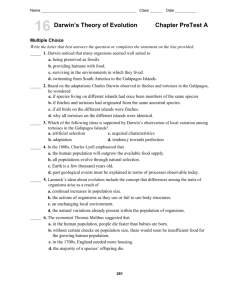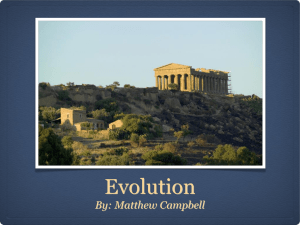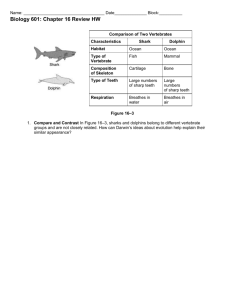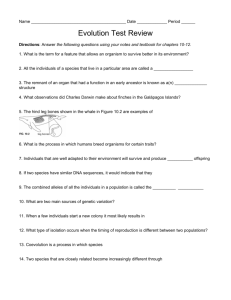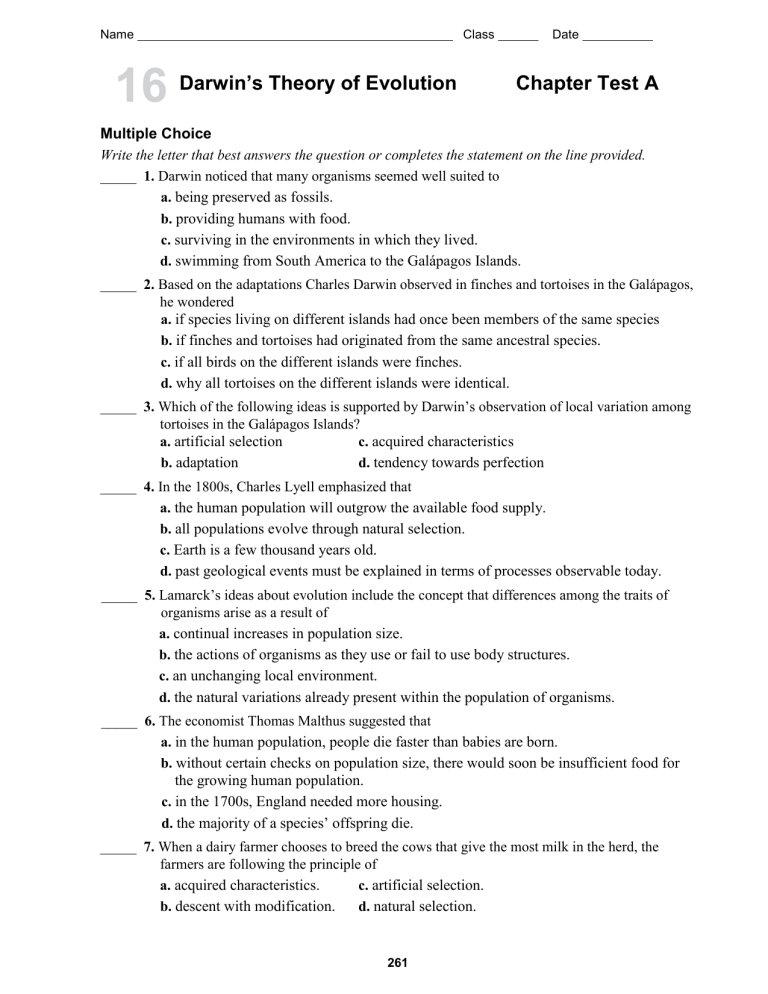
Name Class 16 Darwin’s Theory of Evolution Date Chapter Test A Multiple Choice Write the letter that best answers the question or completes the statement on the line provided. _____ 1. Darwin noticed that many organisms seemed well suited to a. being preserved as fossils. b. providing humans with food. c. surviving in the environments in which they lived. d. swimming from South America to the Galápagos Islands. _____ 2. Based on the adaptations Charles Darwin observed in finches and tortoises in the Galápagos, he wondered a. if species living on different islands had once been members of the same species b. if finches and tortoises had originated from the same ancestral species. c. if all birds on the different islands were finches. d. why all tortoises on the different islands were identical. _____ 3. Which of the following ideas is supported by Darwin’s observation of local variation among tortoises in the Galápagos Islands? a. artificial selection c. acquired characteristics b. adaptation d. tendency towards perfection _____ 4. In the 1800s, Charles Lyell emphasized that a. the human population will outgrow the available food supply. b. all populations evolve through natural selection. c. Earth is a few thousand years old. d. past geological events must be explained in terms of processes observable today. _____ 5. Lamarck’s ideas about evolution include the concept that differences among the traits of organisms arise as a result of a. continual increases in population size. b. the actions of organisms as they use or fail to use body structures. c. an unchanging local environment. d. the natural variations already present within the population of organisms. _____ 6. The economist Thomas Malthus suggested that a. in the human population, people die faster than babies are born. b. without certain checks on population size, there would soon be insufficient food for the growing human population. c. in the 1700s, England needed more housing. d. the majority of a species’ offspring die. _____ 7. When a dairy farmer chooses to breed the cows that give the most milk in the herd, the farmers are following the principle of a. acquired characteristics. c. artificial selection. b. descent with modification. d. natural selection. 261 Name Class Date _____ 8. Each of the following is a condition necessary for natural selection to occur EXCEPT a. more offspring are born than can survive. b. population size is very large. c. fitness varies among individuals. d. there is heritable variation among members of the population. _____ 9. Which statement about the members of a population that live long enough to reproduce is consistent with the theory of evolution by natural selection? a. They transmit characteristics acquired by use and disuse to their offspring. b. They tend to produce fewer offspring than others in the population. c. They are the ones that are best adapted to survive in their environment. d. They will perpetuate unfavorable changes in the species. _____ 10. The principle of common descent helps explain why a. well-adapted species have many offspring. b. conditions in an organism’s environment ensure its survival. c. birds and reptiles share a number of inherited characteristics. d. tigers are so different from cheetahs. _____ 11. Darwin’s concept of natural selection was NOT influenced by a. the work of Charles Lyell. c. his collection of specimens. b. the work of Gregor Mendel. d. his trip on the H.M.S. Beagle. _____ 12. Charles Darwin viewed the fossil record as a. evidence that Earth was very young. b. useful support for his theory. c. interesting but unrelated to the evolution of modern species. d. evidence that traits are acquired through use or disuse. _____ 13. Modern sea star larvae resemble some primitive vertebrate larvae. This similarity may suggest that primitive vertebrates a. share a common ancestor with sea stars. b. evolved from sea stars. c. evolved before sea stars. d. belong to the same species as sea stars. _____ 14. Molecular evidence in support of natural selection includes a. the nearly universal genetic code. b. the presence of vestigial structures. c. a tendency toward perfect, unchanging DNA in various species. d. the transmission of acquired characteristics by DNA. _____ 15. Which characteristic of Galápagos finches helped the Grants show the results of natural selection? a. the color of their feathers b. the length and shape of their wings c. the size and shape of their beaks d. the curve of their claws 262 Name Class Date Modified True/False Indicate whether the statement is true or false. If false, change the underlined word or phrase to make the statement true. _____ 16. Charles Darwin noted that members of a population are identical. ________________________ _____ 17. Evidence that the surface of a mountain was once under the sea includes the presence of marine fossils on the mountain. _________________________ _____ 18. James Hutton and Charles Lyell held similar views about Earth’s age. Both thought that Earth was more than a few thousand years old. Completion Complete each statement on the line provided. 19. According to Lamarck, evolution resulted from the inheritance of _____________ traits. 20. Geologists use ____________________ to determine a rock layer’s absolute age. 21. ____________ proteins, such as cytochrome c, are found in all types of cells from one-celled yeasts to multicellular kangaroos. 22. In studying Galápagos finches, the Grants found that ____________ can take place frequently and over relatively short periods of time. Short Answer In complete sentences, write the answers to the questions on the lines provided. 23. What was the scientific value of the specimens that Charles Darwin brought back to England? 24. How does artificial selection differ from natural selection? 25. What does the continued presence of vestigial structures like the whale pelvis and femur shown in Figure 16–1 suggest about the effect vestigial structures have on fitness? 26. What can be concluded from the similarity in the Hox genes that control limb development in many types of organisms? 263 Figure 16–1 Chapter 16 —Test A Multiple Choice 1. c 2. a 3. b 4. d 5. b 6. b 7. c 8. b 9. c 10. c 11. b 12. b 13. a 14. a 15. c Modified True/False 16. F; differ; are different; have natural variations 17. T 18. T Completion 19. acquired 20. radio-activity; radioactive dating 21. Homologous 22. natural selection; adaptation Short Answer 23. Darwin collected many examples of similar, but not identical, modern organisms as well as fossils that were previously unknown. These specimens helped him form his theory of evolution by natural selection. 24. In artificial selection, humans do the “selecting”—that is, they choose which traits they want to appear in future generations. In natural selection, the environment does the “selecting.” 25. It suggests that there is no disadvantage to fitness associated with the vestigial structures. If there were a disadvantage, then the structures would be selected against and you’d expect them to no longer be present. 26. The similarity of Hox genes in many types of organisms is evidence that the organisms all evolved from a common ancestor.

